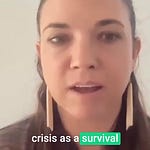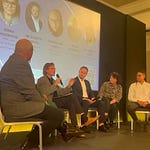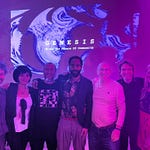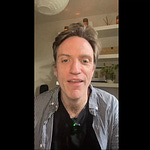By clicking ‘open’ you have collapsed a wave function leading to a more resonant world — thank you! 💚🙏
“If you think you understand quantum mechanics, you don't understand quantum mechanics.” — Richard P. Feynman.
Resonant World #135
I’ve never been a great one for theory.
Practice — what I can touch, feel, and know through direct experience — has always held the greater appeal.
But since I started training in group processes to integrate collective and inter-generational trauma, I’ve had a hunch that developing a more comprehensive theoretical framework to support the work could be a big boost to the movement.
This framework could:
Help practitioners develop new approaches
Make the principles of collective healing clearer and easier to share
Create fertile ground for cross-pollination with the academy
Support healing-centred systems change
Open new avenues for research
In his essential 2020 book Healing Collective Trauma: A Process for Integrating our Intergenerational and Cultural Wounds, the facilitator Thomas Hübl, who I’ve been training with since not long after it was published, sketches many of the key psychological, neurobiological and mystical principles that underpin his work.
Given the importance of making collective healing exponentially more widely available, and its potential global scope, I believe that there’s still plenty of room to elaborate a wider framework that could both include these principles and go beyond them. In particular, I’d love to see the movement develop ever more robust constructs to explain how collective healing work can exert a wider “field effect” capable of impacting people beyond the participants in any given group.
And that’s why I’m so excited about quantum social science.
As Professor
explains in her book You Matter More Than You Think: Quantum Social Change for a Thriving World, this emerging discipline asks how the concepts, interpretations, and formal models of quantum physics might be applied to fields as diverse as international relations, economics, finance, psychology, and sociology.Maybe it’s time to add collective trauma healing to that list?
Conversations That Matter
I had the privilege of being in dialogue on this topic with Karen on Thursday in the first of her series of Conversations That Matter — dialogues exploring the practical applications of quantum social science. (The above video shows the first 25 minutes of our dialogue — before we broadened it to include participants who joined us live. There’s a transcript, further resources, and timestamped show notes below).
I loved having an opportunity to explore the powerful provocation that arises from Karen’s work: What if we’re radically underestimating our capacity for social change?
But in the short time available we were inevitably only barely able to get started on the many ways in which quantum social science intersects with collective healing.
I want to write more about why I think the two fields have so much to learn from each other in future posts, but for now I’ll share a few of the reasons I think this inquiry could be so generative, inspired by Karen’s book You Matter More Than You Think. I’ll also add the caveat that everything here is speculative and provisional — intended to stimulate discussion, rather than provide definitive answers. I’d love to hear reflections in the comments to help refine these ideas further.
Primacy of Consciousness
Unlike ‘classical’ social science — which assumes consciousness arises as an epiphenomenon of matter — quantum social science makes room for the idea that consciousness is primary. In monistic idealist or panpsychic ontologies, even sub-atomic particles can be said to be in some sense conscious — which aligns with the animist vision of many Indigenous cosmologies. Reality is comprised of “consciousness all the way down,” so to speak.
This is relevant for collective healing work, because we place a lot of emphasis on concepts such as the “collective psyche” or “collective unconscious” that are hard to reconcile within a materialist-reductionist paradigm, but which fit comfortably into models of reality where consciousness is primary.
Role of Relationality
From a classical perspective, the large-scale processes at work in society appear to be more complex versions of the kinds of mechanistic processes that govern clocks, machines or computers. It follows that human behaviour should in theory be perfectly predictable — assuming we have enough data.
Quantum social science takes a different view — at least in the vision elaborated by Alexander Wendt, a professor of political science at the Ohio State University, whose book Quantum Mind and Social Science: Unifying Physical and Social Ontology is a foundational text in the field (and written with an engagingly wry wit).
Wendt sees social structures as “superpositions of shared mental states — social wave functions.” These social structures are “continuously popping in and out of existence” according to how people choose to think, act and relate to each other.
Karen explains the significance of Wendt’s take like this:
“In other words, social norms, rules, regulations, and institutions are not ‘really real’ in the sense of having a physical basis, but constructions that materialize through language, shared meaning, identities, beliefs, and values.”
This emphasis on the contingent and relational nature of social structures aligns closely with the concept of “trauma architecture” often used by Thomas Hübl.
Thomas uses the term to convey the idea that so many of our cultural agreements, norms and institutional arrangements are reflections of unintegrated trauma that have concretised through repetition over generations. It follows that we can rewrite these agreements from a more integrated perspective and build a “trauma-restoring” world — echoing the emphasis in quantum social science on the overlooked potential for rapid, system-wide change.
Retrocausality and the Call of the Authentic Future
The weird things that happen around time in collective healing work are also a lot easier to reconcile with a quantum worldview.
Physicist Carlo Rovelli has argued, Karen writes, that the intrinsic quantum indeterminacy of reality “results in a blurred vision of the world that dissolves the distinction between the past and the future.”
This dissolution of linear time chimes with experiences people report in collective healing work of sending healing “backwards” in time to our ancestors. Conversely, many people experience a strong “call” to engage in healing or spiritual work without knowing where this impulse originates, or where it’s guiding them. It may only be years later that the path they were following becomes clear in retrospect — as if the future had somehow been guiding them towards a preordained telos all along. Thomas sums this process up with one of his favourite sayings: “the call is the echo of the arrival.” (A quantum aphorism, if ever I heard one).
A Quantum Leap?
I would love to explore all of this in more depth. To name just a few more potential avenues of inquiry:
I sense a strong resonance between the emphasis on the entangled nature of social systems in quantum social science, and the ‘entanglement’ arising between victims and perpetrators we talk about in collective trauma work, that can be passed through generations, and continues to exert real-world influences until it is acknowledged and integrated.
Likewise, Wendt’s vision of humans as “walking quantum biocomputers” is strikingly close to the understanding Thomas advances in Healing Collective Trauma, albeit expressed in different terms.
I have written before about Karen’s work on fractal agency — and I think there’s a lot more to say about how this concept could apply to collective healing work, and the ways in which it may achieve nonlinear impacts outside of classical chains of cause and effect.
Needless to say, I’m excited to explore how all this may align with the vision of a participatory, conscious universe that stephen marshall and I explored in our new paper SPACETIME 2.0 Reconstructing the Experiential Structure of Reality as a Field for Agency. Comments very welcome!
Ultimately, elaborating a Grand Unified Theory of Collective Healing will be the work of many minds (or the One Mind working through the many🤔?).
In the connection-weaving spirit of Resonant World, I would love to see Karen, Thomas, Alexander and many others in dialogue on what the world of collective healing can learn from quantum social science, and vice-versa.
Perhaps there will come a time to create a hybrid event combining elements of the Quantum Social Science Bootcamps run each summer by the Ohio State University, and the Collective Healing Conference hosted by Thomas and team in the autumn?
In any case, the possibilities emerging from the probabalistic churn of the quantum foam underlying all existence are — by definition — endless.
As ever, I’d love to hear any resonance in the comments.
Keep it quantum!
Further Resources
You Matter More Than You Think
Quantum Social Science Bootcamp III | July 19, 2023 | Alexander Wendt
Quantum Physics and Social Science | Robert Wright & Alexander Wendt [The Wright Show]
Quantum Information Panpsychism Explained | Federico Faggin
Reality Is Not What It Seems. And That Might Just Save the Climate.
Transcript
Show Notes
00:03 — Introduction
02:51 — What does quantum social change mean to you?
03:48 — Default classical worldview vs quantum perspective
04:30 — Superposition, entanglement, fractals, agency, consciousness
04:48 — Quantum social change as theoretical framework for collective healing
06:13 — Risk of grossly underestimating our capacity for social change
07:42 — How does collective trauma relate to global crises?
08:04 — Origins of collective and inter-generational trauma work
10:38 — How collective trauma healing works
11:41 — The shift from the classical to the quantum human
12:16 — Healing backward and forward in time
13:06 — Group healing work as catalyst for fractal agency
15:54 — Potential for global coherence-building to support rapid positive change
16:47 — How to respond to people who say it’s ‘game over’?
18:53 — How presencing unspoken emotions can unlock a new quality of agency
19:32 — Engagement in collective healing practices likely to grow
20:37 — Quantum ‘wild cards’ for the global future
20:46 — Social reality is not what it seems












